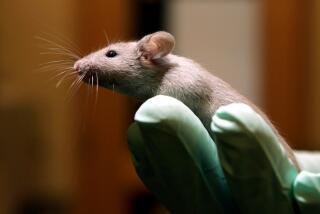Bioengineered rat kidney could lead to treatments for people
- Share via
A team of researchers at Massachusetts General Hospital in Boston has engineered functional rat kidneys by stripping donor kidneys of their cells and then repopulating the remaining collagen substructures with new cells. The bioengineered kidneys produced urine in laboratory dishes and when implanted in living animals.
The advance could be good news for the 100,000 Americans waiting for donor kidneys for transplant, because it suggests that someday scientists might be able to grow custom-made kidneys for people, using a patient’s own cells to seed tissues, said Dr. Harald Ott, a researcher at the Massachusetts General Hospital Center for Regenerative Medicine and senior author of a paper describing the discovery published online Sunday in the journal Nature Medicine.
“My goal was to show it’s possible,” said Ott, who previously created bioengineered rat lungs and rat hearts using the same technique.
The process at the center of his team’s approach is called “decellularization.” In a carefully calibrated process, researchers removed a kidney from a cadaver and then introduced a series of washing agents into its vascular system to remove the organ’s cells and wind up with “a clean slate,” Ott said. Then they introduced immature cells that could form kidney tissues and blood vessels into the acellular scaffold.
“The tricky part for the kidney was how to get the cells in there,” Ott said. At first, the researchers tried pushing the cells through. That didn’t work, but using a vacuum chamber to pull the cells through the organ’s complex system of tubes did. They they cultivated the new cells in an oxygen-rich growth medium.
After a short time, the new kidneys could produce urine. They didn’t work as well as normal, healthy kidneys would — in the laboratory dish, they cleared creatinine (a blood component filtered by the kidneys) 23% as well as a native kidney; once implanted in animals, about 5% to 10% as well. But “the bottom line is, we saw urine production,” Ott said.
Dr. Anthony Atala, director of the Wake Forest Institute for Regenerative Medicine in Winston-Salem, N.C., said the results represented “a nice advance … they show that these technologies do have the potential to help us in the future.”
While scientists have figured out ways to grow simpler human tissues and organs — flat structures like skin, tubular structures like a urethra or a windpipe, hollow organs like a bladder — engineering solid organs has been more difficult, Atala said, because those body parts rely on a complex system of blood vessels that is hard to recreate.
Scientists like Atala, who was not involved in Ott’s research, are looking at a number of types of scaffolds for bioengineered organs. In a famous TED talk from 2011, Atala showed a Long Beach, Calif. audience how 3D printers might be used to build kidneys. But Ott said he liked the decellularization technique precisely because it preserves space for the organ’s vasculature.
“A native matrix is readily available, and it’s very hard to rebuild,” he said.
Atala warned that science’s ability to build solid organs — whether using decellularized organs or on some other structural basis — was still “years ahead.” But the promise is enticing, both researchers said.
“In the ideal world, you’d walk in, we’d take a biopsy and derive the cell types and grow an organ on demand,” Ott said. “It would solve the donor organ shortage and the immunorejection issue” that arises when a donor organ is rejected by a recipient’s body, he added.
Ott’s next step will be scale up the technology to create full-sized human organs, he said.
Follow me on Twitter: @LATerynbrown







